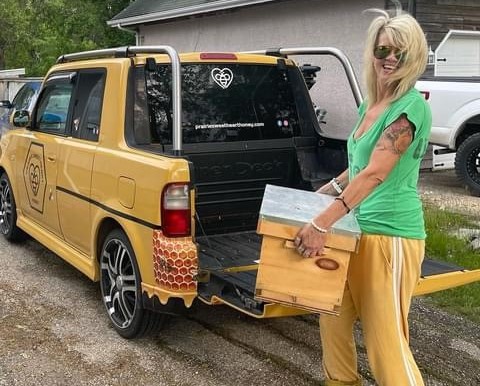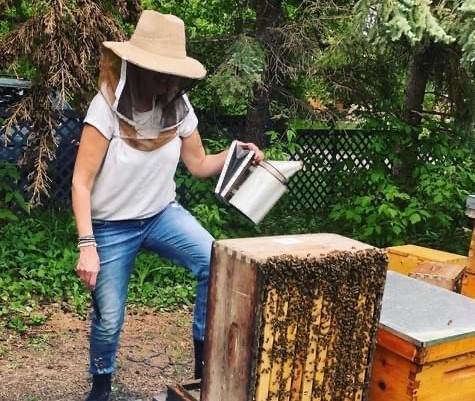
By
Katie Dangerfield
Global News
Published May 25, 2024
8 min read

Chilean queen bees, known for their gentle demeanour and exceptional honey production, are the preferred choice for Winnipeg beekeeper Rebecca Krowelski, who imports them nearly every year for her hive.
“Early spring I often get queens imported and I find Chilean queens overwinter really well,” she said.
A queen bee that overwinters well is vital for a hive’s survival and spring productivity. She ensures the colony’s stability and continuity into the warmer months by remaining healthy through the harsh winter, Krowelski explained.
But this is a common problem for Canadian beekeepers. The country’s cold winters can be harsh, and some queen bees may not survive the season. And it’s not just the harsh winters that are a concern. Declining bee health is wiping out colonies at a faster rate than ever before.

A solution to this dilemma, though one that many believe Canadian beekeepers rely on too heavily, is importing queen bees from warmer countries like Chile, New Zealand, Australia and the southern United States. It’s a practice that beekeepers have needed to rely on more and more over the last few decades. But some experts are sounding the alarm on the risks associated of this reliance.
While importing queen bees can mitigate some winter losses, Krowelski emphasized that the advantages of raising her own queens often outweigh importing them from abroad, provided beekeepers have the time and resources to do so.
“I do like importing my queens, but I also love raising my own queens,” Krowelski said, who has 10 hives in a Winnipeg suburban neighbourhood and sells her honey at farmers’ markets.
“Local queens are the best because we know they overwinter well as they’re acclimatized to our winters, and so that’s one of the biggest benefits,” she explained. “You also choose what you’re selecting, so you look for hygiene and you look for qualities or traits that you want in your queens. Raising my own queens means I don’t have to pay money for them as I use my own resources.”
She noted that this approach may suit small hobbyists like herself, as only a handful of queens are needed. However, commercial farmers may need to explore more efficient methods.
Jeremy Olthof, a beekeeper in Alberta and delegate on the Canadian Honey Council, imports his queen bees each spring. He said the average cost of a queen is around $50.
He runs Tees Bees Inc., a commercial honey producer and pollinator in central Alberta. The company manages anywhere from 3,000 to 5,000 hives, depending on the year. And to keep up with the pollination need, he imports his queen bees from California every year.
“We have such a short season, and making queens is very labour intensive, it takes good weather. So for us to get our hives strong enough in time to make our honey flow, we have to have queens early,” he told Global News. “So that’s why places like California and Hawaii specifically, they’re raising their queens in January and February. They can just get things going so much earlier.”
A quarter of Olthof’s honeybees pollinate hybrid canola in the province, and he said he needs to have the colonies at full strength by early July.
The process, however, isn’t without its regulatory hurdles.
All bee imports into Canada require an import permit from the Canadian Food Inspection Agency (CFIA). Queen bees can only be imported from approved CFIA countries: United States, Chile, Australia, New Zealand, Denmark, Italy and Malta.
But despite the bureaucratic hoops, the numbers tell a compelling story: in 2023 alone, 343,125 foreign queen bees made their way into Canadian hives, predominantly from California and Hawaii, according to Agriculture and Agri-Food Canada.
This influx of foreign royalty isn’t merely a matter of convenience; it’s a lifeline for Canadian beekeepers, like Olthof, grappling with alarming colony losses. Over the past decade, honey bee health has declined due to various reasons, with the biggest one being varroa mites — a parasitic bug that attacks and feeds on bees.
During the 2022 to 2023 winter season, Canada experienced a national bee colony loss of 32.2 per cent, with provincial losses ranging from 11.7 per cent to 46.2 per cent. This rate is higher than the average annual loss of 27 per cent reported from 2007 to 2022, according to the Canadian Association of Professional Apiculturists (CAPA).
The 2021 to 2022 season was the worst beekeeping season on record for Canada. The national winter loss was 45.5 per cent, with provincial losses ranging from 15.3 per cent to 57.2 per cent. This national loss was nearly double the average annual loss of 25.8 per cent reported between 2007 and 2021.
“2021 was when almost half the bees in Canada died. And that led to everyone scrambling and an uptick in queen importation because that’s how we gain our numbers back,” Olthof said. “It’s widespread losses and we’re scratching our heads. There are pockets of complete wipeouts and we’re still trying to figure it out.”
To offset these losses, beekeepers turn to imported queens to establish new colonies. The CAPA reports that the reliance on imported queen bees has steadily gained over the past decades. For example, more than 19,000 queens were imported in 1988 compared to early June 2017 when Canadian beekeepers had already purchased 207,764 queens from the U.S. and 18,216 queens from other international sources.
On May 14, Ontario beekeeper Peter Dicks headed to the Toronto airport to pick up 75 Australian queen bees.
Dicks is the beekeeper at Springridge Farms in Milton, Ont., that makes an assortment of honey. The farm currently has two colonies that also help pollinate crops, such as strawberries, pumpkins and gourds.
He said every year he hopes his bees will survive the winter season, but because of the rise of varroa mites, it’s becoming more and more frequent that colonies will not survive the winter.
To help with the loss, Springridge used foreign queen bees to help build up its colonies.
Here’s how it works.
Once ordered, the international producer places the queen bee into a small wooden box alongside attendant bees that feed and care for her during the journey.
After being placed in the wooden box with her attendants, the queen bee and her companions embark on their journey to Canada. The box is carefully packaged to ensure their safety and then transported, often by air, to minimize travel time. Upon arrival in Canada, the beekeeper retrieves the package from the airport or post office.
Once in the beekeeper’s hands, the queen is gradually introduced to her new hive. This careful introduction involves placing the box inside the hive and allowing the resident bees to become accustomed to her scent. Over a few days, the bees chew through a candy plug in the box, releasing the queen into the hive.
“It acts like a time delay mechanism to allow her pheromones to become one within the new colony, so that she’s not killed by the bees that are in there,” Dicks said.
If the queen is accepted, she typically starts laying eggs within a few days to a week, depending on her acclimation to the new hive and the acceptance process by the worker bees.
This reliance on foreign monarchs comes with its own set of challenges.
Queen bees accustomed to warmer climates often struggle to adapt to Canada’s harsh winters, raising questions about their long-term viability, the Canadian Association of Professional Apiculturists reported. While researchers strive to unravel the mysteries of successful queen overwintering, beekeepers face a pressing need for immediate solutions.
Another drawback is that some queens don’t survive the flight to Canada, and sometimes they are left in delivery stores for days, killing the queen and her attendants, he added.
Imported queens are also at risk of bringing in diseases, the CFIA told Global News in an email on May 17.
“Risks vary from country to country but they can include diseases or pests that might negatively impact the Canadian bee population including tropilaelaps mites, killer bees, small hive beetles, amitraz-resistant varroa mites and oxytetracycline-resistant American foulbrood,” a spokesperson stated.
Because of this, Olthof said there is pressure from federal and provincial governments for beekeepers to reduce their reliance on foreign queen bees.
Provinces like Saskatchewan have been leading this initiative by maintaining their own domestic supply of bees, he said.
Known as the Saskatraz Breeding Program, its objective is to produce queen bees in adequate numbers, at reasonable prices, for commercial beekeepers every spring.
The CFIA told Global News that it “continues to work with industry, the provinces and a range of other stakeholders to help increase domestic honey bee supplies and to explore potential solutions to help improve the resiliency of the beekeeping industry.”
Despite the option to produce his own queens, Olthof said he’s currently opting to continue importing them.
“It takes a lot of skill and knowledge and I’d rather just buy them,” he said.
Despite the challenges of raising bees in a colder climate, beekeepers like Krowelski remain dedicated, driven by their love for these vital insects.

“I fell in love with the bees and they give so much back to me,” she said.
She mentioned friends and fellow beekeepers she follows on Instagram, saying that bees have also saved their lives during difficult times.
“I think so many people find this passion and the bees give back so much, so it’s worth the work that is involved in keeping up with it all.”




Comments